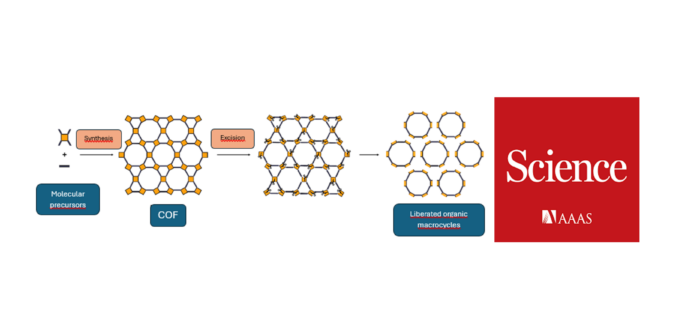- A team of scientists from ICN2 has managed to produce a type of organic molecules, known as macrocycles, through the precise and controlled breaking of crystalline structures.
- This technique allows molecular “cutting” of the target molecules instead of synthesizing them step by step using traditional methods.
- This is an international collaboration with participation from UdG researchers, and the results have been published in the prestigious journal Science.
Girona, June 20, 2025.
Researchers from the Catalan Institute of Nanoscience and Nanotechnology (ICN2) have led the development of a pioneering strategy to obtain different types of organic molecules through a process of molecular “cutting.” This approach enables the rapid and precise production of these molecules without relying on traditional chemical synthesis methods. The results pave the way for the simple and efficient creation of complex molecules, with great potential for the development of new materials.
Specifically, the study presents a method to cut out macrocycles, a type of cyclic organic molecule currently used in fields such as the food industry, cosmetics, or drug delivery. To do this, they used larger, porous, crystalline chemical structures known as COFs (covalent organic frameworks), which contained these organic macrocycles inside them. COFs are widely used in fields such as gas storage or chemical separation processes.
The study, published in the journal Science, is the result of an international collaboration involving researchers from institutions such as the Universitat Autònoma de Barcelona (UAB), the University of Girona, the University of California Berkeley, and the Institute of Materials Science of Barcelona (ICMAB-CSIC).
Clip-off Chemistry: The art of “cutting” molecules
The strategy used is based on the concept of “Clip-off” Chemistry, developed under the leadership of ICREA professor Daniel Maspoch, head of the Supramolecular NanoChemistry and Materials group at ICN2, and lead author of the article. This strategy involves using materials that already contain the desired molecules inside them and then cutting them out.
The COFs used in the study were previously designed from simple precursors, including chemical bonds that are easily breakable at strategic positions (in this case, double and triple bonds between carbon atoms, also known as olefinic or alkyne bonds).
Once the COFs were designed, the next step was to release the macrocycles. To do this, ozone—a gas made up of three oxygen atoms—was used as a “molecular scalpel,” capable of breaking those double and triple bonds in a process known as ozonolysis. As a result, the organic macrocycles are efficiently and quickly released, avoiding lengthy and complicated synthesis processes.
As Prof. Maspoch himself highlights: “We design materials that already contain the rings we’re looking for, using simple precursors—like LEGO pieces—and then release them with surgical precision.

Image. Diagram of the synthesis process of COFs and subsequent cleavage and release of macrocycles through ozonolysis.
Huge potential in multiple fields
Using this method, researchers succeeded in synthesizing up to nine different types of macrocycles (with sizes reaching up to 162 atoms). These included various types of organic cyclic structures such as polyamides and polyimides, as well as several functional groups like aldehydes, carboxyl, and fluoro groups—demonstrating the great versatility of the method.
Subsequently, the chemical structure of the macrocycles was confirmed using advanced techniques such as scanning tunneling microscopy and mass spectrometry. Researchers from the Institute of Computational Chemistry and Catalysis (IQCC) and the Technical Research Services of the University of Girona, led by Prof. Xavi Ribas, played a key role in this process.
According to the authors:
“This method lays the foundation for a completely innovative and versatile way to obtain complex molecules. It could have great application potential in fields as diverse as organic chemistry, nanotechnology, or the design of new materials, devices, biosensors, etc.”
Article reference:
Roberto Sánchez-Naya, Juan Pablo Cavalieri, Jorge Albalad, Alba Cortés-Martínez, Kaiyu Wang, Carles Fuertes-Espinosa, Teodor Parella, Sara Fiori, Esteve Ribas, Aitor Mugarza, Xavi Ribas, Jordi Faraudo, Omar M. Yaghi, Inhar Imaz, Daniel Maspoch
Excision of organic macrocycles from covalent organic frameworks. Science (2025).
DOI: 10.1126/science.adw4126
Contact details:
- Prof. Daniel Maspoch (daniel.maspoch@icn2.cat)
ICREA Professor and Group Leader
Supramolecular NanoChemistry and Materials Group (ICN2) - Prof. Xavi Ribas (xavi.ribas@udg.edu)
Director of the Institute of Computational Chemistry and Catalysis (IQCC) and Professor in the Department of Chemistry, University of Girona
Girona, June 20th, 2025
For more info: ges.iqcc@udg.edu

